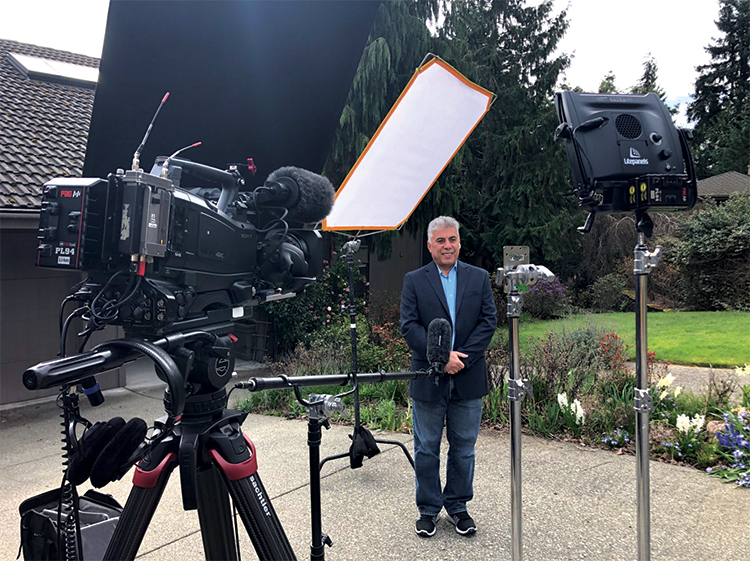COVID-19 puts UW’s Institute for Health Metrics and Evaluation in the spotlight

Ali Mokdad, professor of epidemiology, steps outside his home in April to talk to a national TV station about forecasting the spread of the virus. Newspapers and news programs around the country are turning to UW health experts and those in other fields to find insight into COVID-19. (Photo courtesy of Ali Mokdad)
At the end of March, Ali Mokdad, a UW epidemiologist, reached out to Florida health officials to encourage the state to adopt a blanket stay-at-home order to slow the spread of COVID-19. Up to that point, the governor was not considering such an action. But Mokdad’s call, and that the White House was citing the UW’s Institute for Health Metrics and Evaluation projections for the spread and death toll of the virus, helped persuade state leaders to change their thinking.
The IHME had been working since February on projecting the evolution of the COVID-19 pandemic so that hospitals, including UW Medicine, could know if and when to open up beds, ramp up staffing and equipment, and prepare for the worst. As the pandemic expanded across the country, more and more local, regional and national leaders considered to the projections as they made their own plans for preparations and closures.
Thanks to the IHME and the readiness of the region’s providers to react, “The UW was way ahead of everybody,” says Mokdad. “We prepared our hospitals and canceled elective surgeries … and whenever we asked for volunteers (health care professionals) we had more than we asked for.”
Mokdad and IHME director Dr. Christopher Murray have since stepped in front of the cameras to further share and explain the IHME projections, which are frequently updated. They have discussed the exponential spread of the disease without social distancing measures and the dangers of trying to return to normal life and business too soon.
The IHME was founded in 2007 with a $279 million investment by the Bill & Melinda Gates Foundation. Growing from three staff members to 500—with collaborations around the globe—the mission remains the same: to provide sound information to policy-makers and donors to help improve the human condition.
By taking in data—in this case including social-distancing measures and closures of businesses and schools, as well as health spending—the institute creates scenarios and project outcomes. In mid-April, the institute expanded its work to consider anonymized mobile phone data to get a better picture of how social distancing is working across locations. What they found was that social distancing—even in places like Florida, which was late to take action—was occurring earlier and to a greater degree than originally estimated. With a nearly nationwide effort to slow the spread of the disease, the picture started improving.
But then in early May, the IHME projections changed again. The new data considers that some states have eased up on social-distancing measures and that there will be changes in mobility during the summer months. Now the estimated infection rates and death toll have increased—rising from the prior prediction of about 70,000 deaths across the country by mid-August to 147,000. “The trajectory of the pandemic will change—and dramatically for the worse—if people ease up on social distancing or relax with other precautions,” says Murray. “We encourage everyone to adhere to those precautions to help save lives.”
Estimates like the IHME’s and the use of them by national or regional governments may not halt the disease, but they buy everyone time to find better methods for containment and treatment. “There is no geography here, there are no boundaries,” says Mokdad. “It will impact all of us. It does not matter what our race is or what our age is.”